
HOME / Departments / Earth and Planetary Sciences / Atmosphere–Ionosphere Coupling and Space Weather
Atmosphere–Ionosphere Coupling and Space Weather
-
- Liu Huixin, Professor
ion-neutral coupling processes on Earth and other planets
In space, which extends far above the clouds, there is an electrically conductive gas called the ionosphere, whose density and temperature are constantly changing. These changes are called "space weather". Though seeming far, space weather is actually closely related to our daily lives via its impacts on critical social infrastructure such as GPS, wireless communications, and power grids on a global scale. Therefore, countries around the world are collaborating vigorously to advance our understanding towards space weather and to develop space weather forecasting.
Our laboratory is active in conducting basic and applied research on space weather under three pillars: 1) elucidation of the coupled atmospheric and ionospheric processes on the Earth; 2) understanding of the coupled atmospheric and ionospheric elementary processes on the Mars and other planets; and 3) understanding of the space weather phenomena on the Earth. (2) Elucidation of space weather phenomena on Mars and other planets and promotion of comparative planetary research; and (3) Application to ionospheric space weather forecasting. The following is a brief explanation of the above. These research are done with close collaboration with NASA, NCAR (National Center for Atmospheric Research), DLR (German Atmospheric Physics Laboratory), and the Space Weather Prediction Center in Japan.
① Atmosphere–Ionosphere coupling on Earth
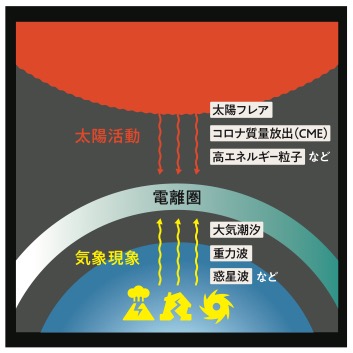
The ionosphere, which occupies 70-1000 km above the sea surface, is affected daily by solar activity from above and meteorological events from below (typhoons, tsunamis, volcanic eruptions and earthquakes) (right figure). This connection between meteorology and space weather is the cutting edge research in the Sun-Earth connection science that has attracted much attention in recent years. We are studying various space weather phenomena with the aim of elucidating this connection.
One example for the atmospheric–ionospheric connection is the eruption of Tonga Volcano on January 15, 2022 (see figure below). During this eruption, various atmospheric waves such as the Lamb wave and sound wave were excited and propagated up to the ionosphere, which caused significant disturbances to the global ionospheric density and structure.
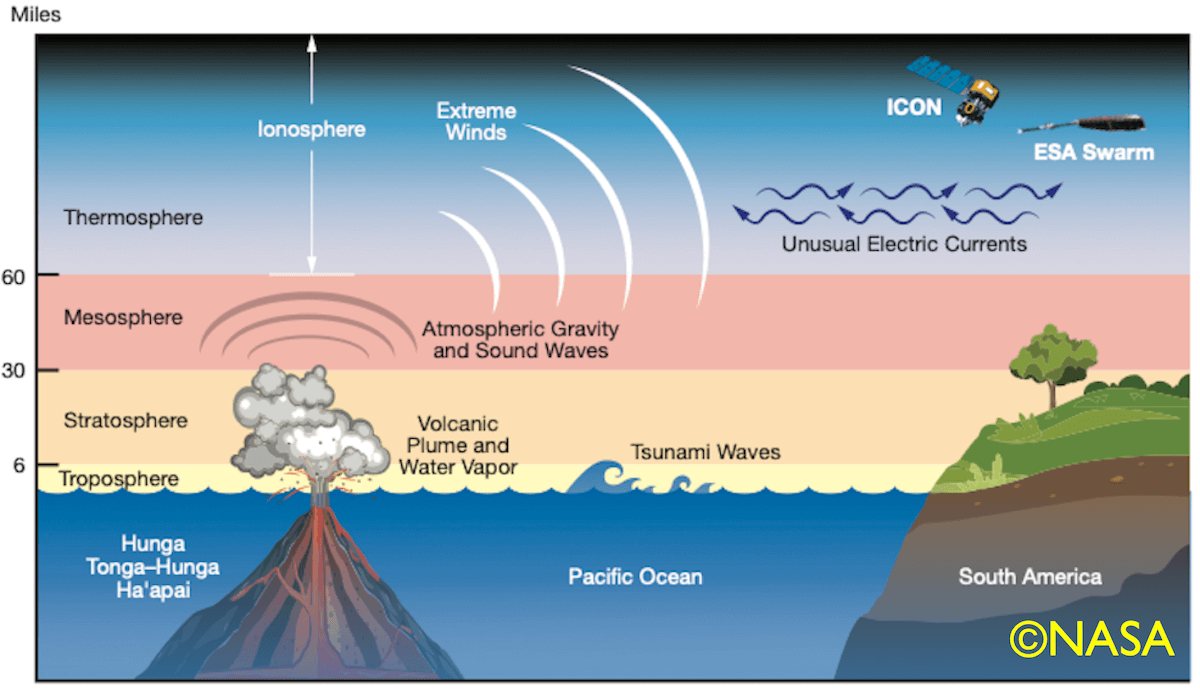
Recent studies have revealed that atmospheric–ionospheric coupling occurs not only in violent phenomena such as volcanic eruptions, but also on various spatial–temporal scales. For example, our laboratory was the first in the world to elucidate that convective activity in the tropics affects the distribution of gravity waves in the ionosphere and thermosphere. We also conduct research on much longer time scales, and study the impact of stratosphere sudden warming, global warming and El Niño climate change on the ionosphere and thermosphere.
In our research, we mainly use satellite observations from NASA and ESA, and numerical simulations of WACCM-X from the National Center for Atmospheric Research (NCAR), the world's most advanced atmosphere–ionosphere coupled model, to promote international collaborations.
②Atmosphere-Ionosphere on Mars
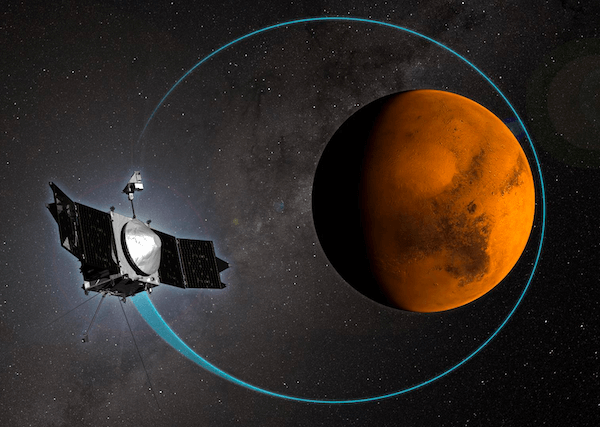
We also study the atmospheric–ionospheric coupling on other planets from the aspect of comparative planetary science. In particular, we study vertical coupling processes on Mars using various satellites like NASA's MAVEN, etc.
The Martian atmosphere is composed mainly of carbon dioxide (mole fraction 95.32%) and has a thinner atmosphere compared to Earth (atmospheric pressure is about 1/100th that of Earth). In addition, Mars has no Earth-like dipole magnetic field but a very weak crustal remnant magnetic field in the southern hemisphere (as a remnant of the past magnetic field), making it susceptible to solar wind and other influences from space.
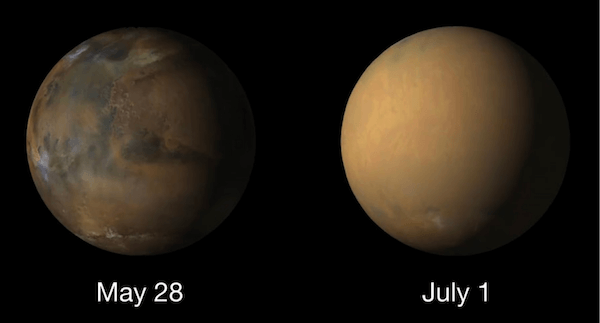
Similar to space weather research on Earth, we study lower atmosphere forcing on the thermosphere/ionosphere on Mars. One such event is dust storms, which frequently occurs on Mars and has significant impact on the energy and dynamics through out the Martian atmosphere-ionosphere.
③Connecting to Space Weather Forecast
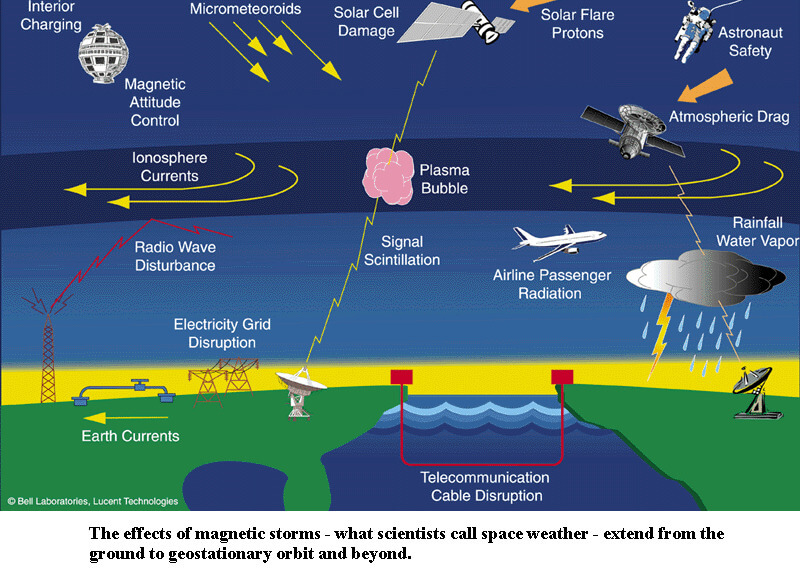
Since ionospheric disturbances affect communication satellites, long-range wireless communications, GPS precision positioning, and satellite orbit control, space weather forecasting is strongly demanded by society. Current work on this topic in my group are mainly related to three key space weather elements: (1) the structural characteristics and generation mechanism of the ionospheric sporadic E layer (Es) that greatly affects HF/VHF communications (used by ship and airplanes); (2) the characteristics and generation mechanism of ionospheric plasma bubbles that affect satellite precision positioning; (3) the thermospheric density directly related to satellite orbit control. (1) and (2) are joint research with the National Institute for Communication Technology (NICT) and Nagoya University. (3) is in collaboration with JAXA.
A prominent feature of my group is its broad range of international collaboration with world top class researchers in renowned institutions around the world like NCAR and NASA. We have over 10 researchers, PhD students visiting each year in addition from these institutions and many others. If you're interested in collaborating or visiting our lab, please feel free to drop me an email. Here is an introduction of our lab in japanese: https://www.kyushu-u.ac.jp/f/55335/kyudaikoho128_web_2.pdf (15-17 page)